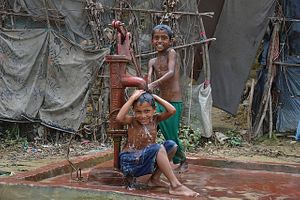The plight of the Rohingya – the stateless Muslim people fleeing persecution and violence in the Rakhine state of Myanmar – has become well known. The Rakhine state borders the Bay of Bengal and the southeastern tip of Bangladesh. Recurrent violence and torture has forced hundreds of thousands of Rohingya to flee Myanmar. Owing to its proximity, more than 300,000 displaced Rohingya have entered Bangladesh in recent years and nearly 70,000 more since late last year.
Having faced its own humanitarian and refugee situation during its war of liberation against Pakistan in 1971, Bangladesh is sensitive to people seeking protection from torture and exclusion. That is why Bangladesh, which only two years ago climbed into lower-middle-income status in the World Bank rankings, has been expending significant government resources to help the displaced Rohingya in Bangladesh.
Bangladesh strongly supports the recommendations of a June 2016 report of the United Nations High Commissioner for Human Rights on the Rohingya situation in Myanmar, which include: an abolition of discriminatory local orders against the Rohingya in Rakhine State, the lifting of restrictive bureaucratic requirements for emergency medical referrals and the establishment of guidelines that will eventually eliminate all freedom-of-movement restrictions on the Rohingya.
Bangladesh has successfully repatriated more than 236,500 Myanmar refugees through an agreement negotiated between the two nations in 1991-92 – until the process was halted by Myanmar in 2005. The remaining Myanmar refugees, numbering more than 33,000 now, are living in two camps in Cox’s Bazar, a coastal district near the border of Myanmar’s Rakhine State. But the Rohingya, having been denied citizenship in Myanmar, were forced to leave their homeland. Over the last decade, nearly 300,000 have entered Bangladesh and taken shelter in makeshift settlements in and around Cox’s Bazar.
The Cox’s Bazar settlements are not an ideal or tenable solution. Although the Bangladesh government has done its best, the sheer number of Rohingya living there has posed socio-economic, demographic, environmental, political, humanitarian and security challenges. It’s difficult for the government and NGOs to distribute assistance to the Rohingya in the settlement camps.
The Rohingya population is extremely vulnerable and its size is well beyond the capacity of the local administration to manage. Criminal networks have emerged that are engaging in narcotics smuggling and human trafficking. Adding more settlements to the Cox’s Bazar area, loading more onto an already over-strained system, is not feasible.
As an alternative, the government of Bangladesh has crafted a plan that would relocate the Rohingya population to Thengar Char, an island in the northern Bay of Bengal at the mouth of the Meghna River, north of Cox’s Bazar and south of the capital of Dhaka.
Conditions in this new settlement will be far better than what the Rohingya have in Cox’s Bazar. The government will build housing, schools, hospitals and health centers, mosques and roads.
Some news reports have falsely claimed that Thengar Char is completely submerged for part of the year, a baseless allegation that subjected the government to unwarranted criticism. Bangladesh Prime Minister Sheikh Hasina dispatched a team of researchers to Thengar Char to closely examine its condition. The truth is that, as in any tidal region, waters rise and fall daily. As a result, a small percentage of Thengar Char – the coastline – is under water half of each day, at high tide, then exposed again at low tide. The vast majority of Thengar Char is never submerged.
The Bangladesh government will not build Rohingya settlement facilities in those areas of Thengar Char that are subject to tidal fluctuations. It is also doing its best to handle the influx of Rohingya people in the most humanitarian way.
During a recent hearing of the Tom Lantos Commission on Human Rights in the U.S. House of Representatives, Matthew Smith, CEO of Fortify Rights, who has visited the Rohingya camps in Bangladesh, said he is sympathetic with the challenges the Bangladesh government faces from the crush of refugees.
Another witness at the hearing, Andrea Gittleman, program manager of the Simon-Skjodt Center for the Prevention of Genocide, also recently visited Rohingya population living in Bangladesh and said that the Bangladesh government believes that the root of the Rohingya crisis must be solved in Myanmar.
Correct. The solution to the Rohingya crisis must be based in Myanmar and it will take many international hands. Bangladesh asks its international friends for help in developing Thengar Char and transporting the refugees there. It also seeks support for the sustainable return of the Rohingya to their homeland in Myanmar, in safety, security and dignity.
Sajeeb Wazed is the information technology adviser to Bangladesh Prime Minister Sheikh Hasina.

































